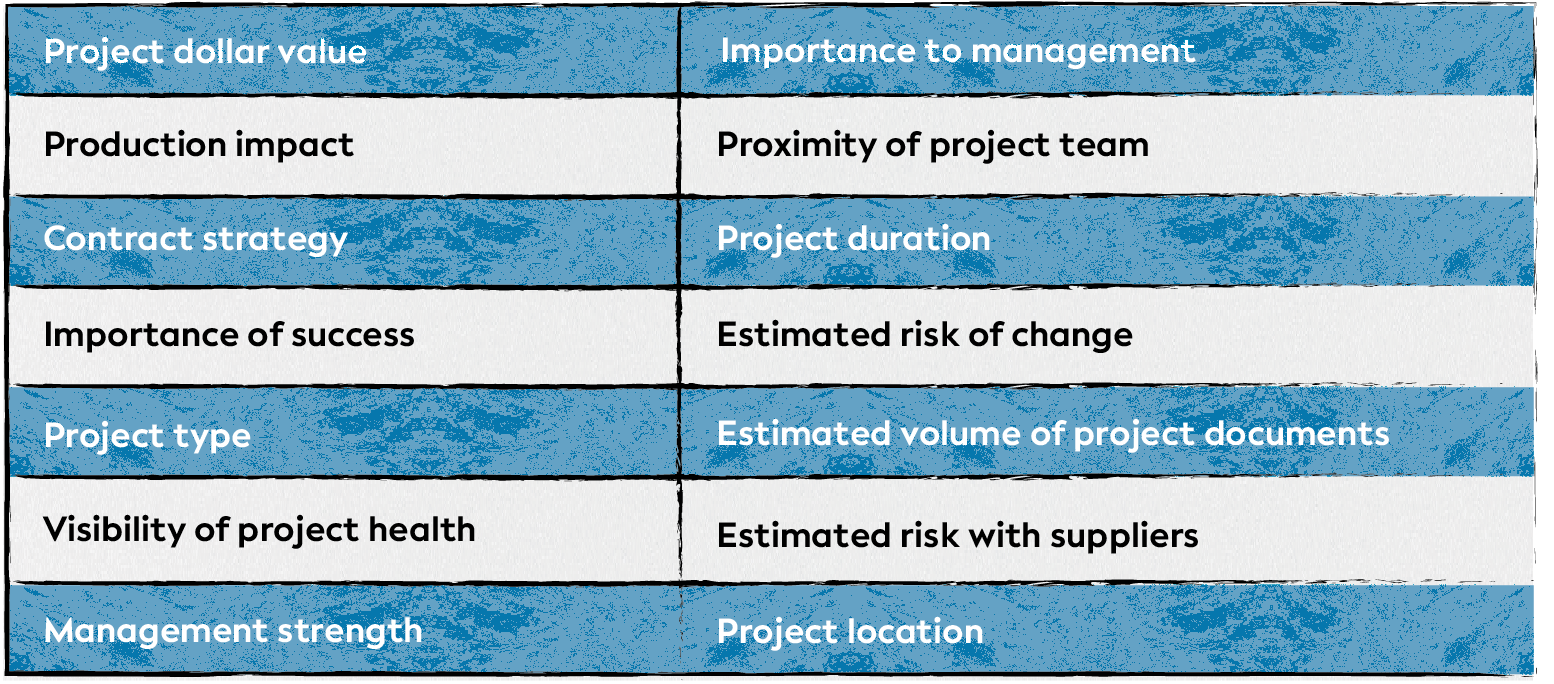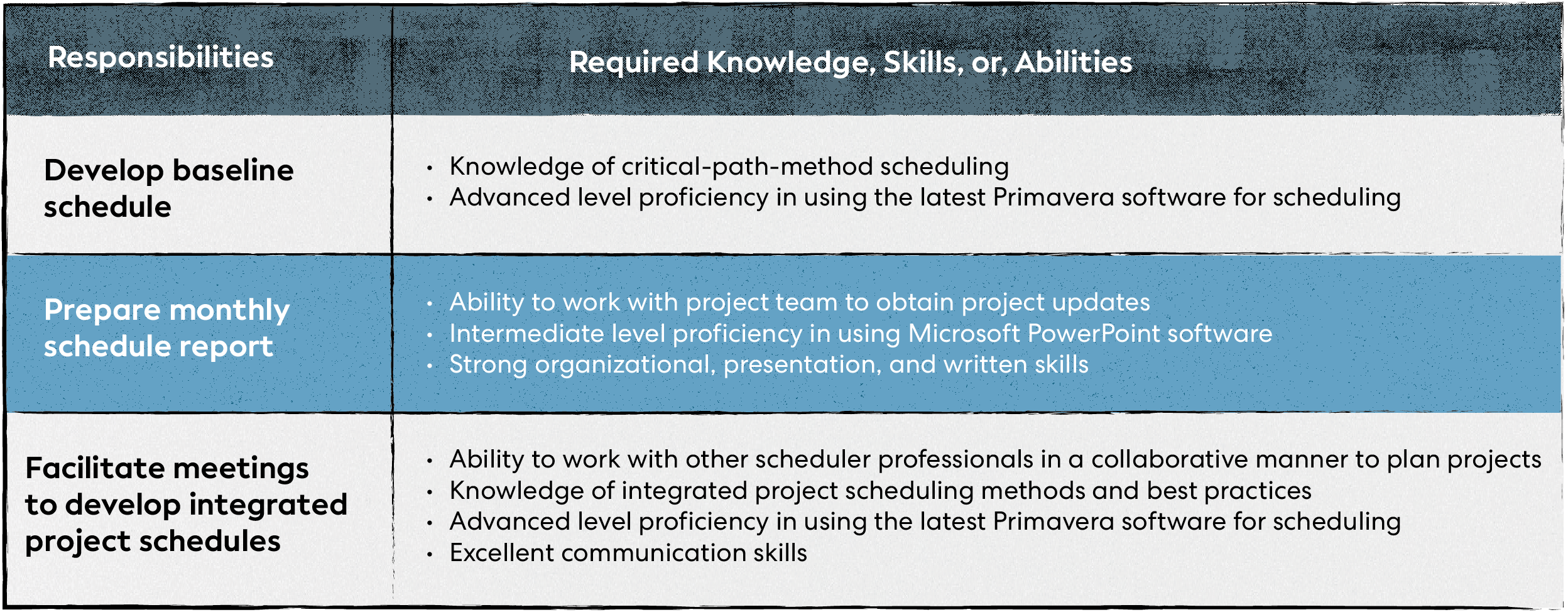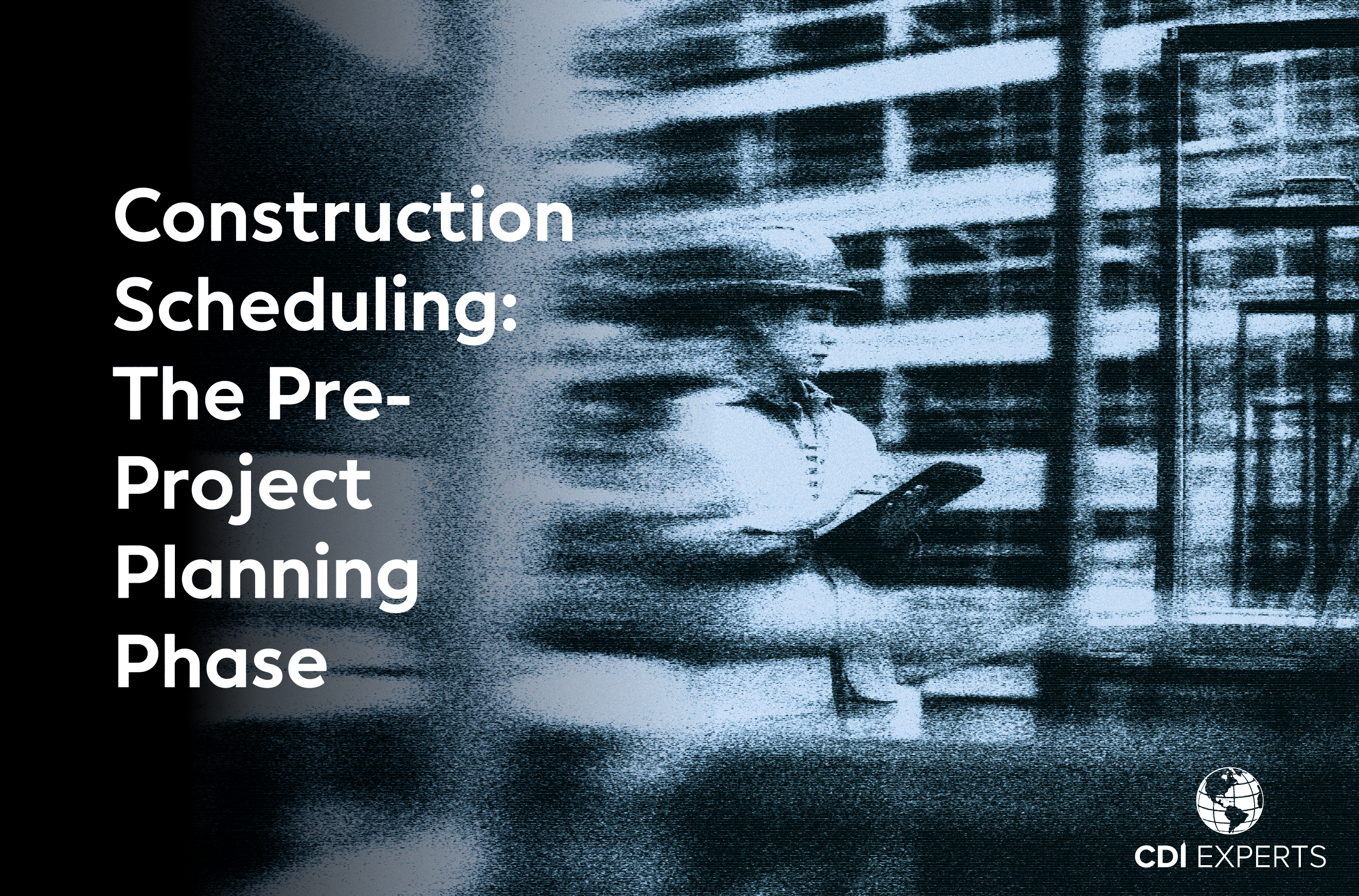Written by
Christopher Carson
Published
22 March 2023
The pre-project planning phase establishes the foundation for how the project will be executed. It is important to dedicate the appropriate amount of time and focus to pre-planning in order to properly define, plan, develop, and initiate key components of a project. When pre-planning is executed properly, projects run smoothly and typically have higher rates of success. This section discusses the development of an entire project control team, of which the planning and scheduling roles are an integral part of the organization. This section helps explain the role and interaction of the planner/scheduler with the rest of the project team based on the best practices that have been identified by project controls practitioners.

1.1 Selecting the project controls team
Selecting the project controls team is vital to the pre-project planning phase. The team should be selected and start contributing to the project during the pre-planning phase. Many project managers wait too long to engage the right resources which shifts the focus of the team to always reacting and trying to “play” catch-up. If the project controls team is in place at the right time, however, they can establish the right tools, processes, and procedures and contribute proactively to the success of the project. Selecting the project controls team comprises the following topics:
1.1.1 Roles and Responsibilities
1.1.2 Evaluation of Capabilities
1.1.3 Team Formation
It is important to clearly define the roles and responsibilities of the project controls team because it provides the framework for how the team will work together in accomplishing the project goals and objectives. The roles and responsibilities must be documented and communicated to the team so there is a clear understanding of responsibility, accountability, and level of authority. It is also important to properly evaluate the capabilities and competencies of the project controls team members to ensure the proper talent is assigned to the team. The evaluation of capabilities and competencies is the process of assessing the current knowledge and skill of team members as well as their future potential to successfully perform the responsibilities in project controls.
Team formation defines the specific positions within and the structure of the project controls team. The organizational structure also defines how the project controls team is related to the rest of the project team, defining clear lines of communication and authority.

Purpose
It is important to clearly define the roles and responsibilities of the project controls team because it provides the framework for how the team will work together in accomplishing the project goals. The proper definition and team buy-in of the roles and responsibilities will optimize the teams to be more productive, effective, and harmonious. For individual team members, it provides a clear expectation of their responsibilities, how they will support other team members, and how other team members will support them. Finally, an effective definition of roles and responsibilities will provide a clear framework of accountability for each role.
Best Practices
The process of defining roles and responsibilities should start after the requirements of the project, project criteria, and goals for project controls are defined. It supports the selection process for the project controls team. The first step is to define the required level of project control necessary to support the type of project and the goals and objectives for the project. The level of project control varies with each project, depending on the variety of characteristics, or criteria. For example, “complex and high risk projects require more control than simple projects.” The following criteria should be considered to help determine the appropriate level of project controls for any given project.
Project Criteria

Every company can develop its own list of criteria as the appropriate criteria may vary across organizations. Defining the roles and assigning the responsibilities starts with a leader, usually the project manager or project controls manager, who determines the high level expectations and responsibilities for project controls. The responsibilities should then be defined with the appropriate level of detail. For example, is it sufficient to define the work as simply “schedule project” or should there be more specific tasks such as “develop schedule coding structure,” “define schedule specifications,” and “resource load schedule”? The next step is to identify the different roles that will support the project controls activities, such as scheduler and cost engineer. The final step is to define the relationship between roles and responsibilities. The output of this session is typically a document or a matrix depicting the roles and responsibilities for the project controls team. A common type of matrix is called the responsibility assignment matrix (RAM). This matrix typically lists the activities of work and deliverables down the page in vertical rows and lists the roles horizontally across the top of the page. In the most basic format, the relationship between the role and the work is simply indicated with an “x” in the matrix cell where the role and work intersect.
Regardless of the type of tools used to define and communicate the roles and responsibilities, the key is for all the team members to clearly understand their roles, responsibilities, and levels of authority in order to effectively support the project goals and objectives.
Recommended Practice
Regardless of the type of tools used to define and communicate the roles and responsibilities, the key is for all the team members to clearly understand their roles, responsibilities, and levels of authority in order to effectively support the project goals and objectives.
Table 1-1: Project controls team RACI-abbreviated sample

Table 1-2: RACI definitions
In the use of RACIs, the role can be defined generally, such as by department or function. The roles can be further defined by job title, such as “scheduler” or by the specific name of the person who will be responsible for the tasks.
In some cases, the role can have responsibility for the work, task, or deliverable and the role can also have accountability. Where this is applicable, select “Accountable” as the participation type. In the “Project Controls Team RACI” example shown in Table 1-2, the project controls manager is both responsible and accountable for defining the Work Breakdown Structure (WBS).
Because there are many different styles and approaches, it is important to provide a legend, similar to Table 1-2, to define the precise meaning of the different participation types in the RACI for each project so there is a clear understanding for everyone.
In using a RACI, it is important to include any roles that require information on the status of the work being performed, or in other words, the “inform” participant type. For example, if the project controls team is required to inform the project manager on certain activities, then the project manager needs to be a role defined on the RACI. In fact, any interactions with roles outside of the project controls team should be included in the RACI.
Advisories
Avoid delaying the definition and communication of the roles and responsibilities for the project controls team. These should be clear before the project controls effort engages. If creating a RACI responsibility matrix, avoid using multiple participation types (Responsible, Accountable, Consult, or Inform) for any one task/role combination. In other words, each role for each task should have only one participation type defined.

1.1.2 Evaluation of Capabilities
Evaluating the capabilities and competencies is another part of the pre-project planning phase and further supports the selection process for the project controls team.
Definitions
The evaluation of capabilities and competencies is the process of assessing each team member’s current knowledge and skill, as well as his or her future potential to successfully perform the responsibilities in project controls.
Capability is the potential for a person to be developed for future opportunities. It is important to understand the capability of prospective members of the project controls team to see how they could be trained and coached to develop into different positions.
Competence is the demonstrated use of knowledge, skill, and ability to consistently perform tasks. It is important to understand the competence of prospective members of the project controls team to evaluate how they can perform current responsibilities required to meet the goals and objectives of the project.
Purpose
The evaluation of capabilities and competencies is a critical step in selecting the project controls team to determine if individuals can effectively and efficiently perform their roles and responsibilities.
Default Condition
A careful review of capabilities and competencies should be performed on every project to ensure the project controls team will have the proper skill-sets and sufficient experience to be successful. Failure to adequately evaluate capabilities and competencies can lead to selecting the wrong team members, which could cause ineffective project controls, higher project risk, and the inability to meet project goals and objectives.

Best Practices
It is important to first define the key capabilities and competencies required for the members of the project controls team. Questions to ask include: What is required to support the roles and responsibilities on this project? More specifically, what are the important skills the scheduler should have to perform their duties and responsibilities on the project? Should the scheduler demonstrate experience in a particular software tool?
After the key capability and competency requirements are defined, potential team members can be evaluated to determine if they meet the needs of the project controls team for a particular project.
There are a variety of methods to evaluate capabilities and competencies, ranging from structured interviews to questionnaires to testing. The evaluations are typically performed by the project manager or project controls manager.
Capabilities are more difficult to assess because the focus is on a person’s capacity and potential to develop the specific knowledge and skills required for a project controls position.
The following example, shown in Table 1-3, pertains to a project controls manager’s evaluation of whether or not a prospective scheduler should be selected to join the team. In the example shown in Table 1-3, the project manager is using his or her judgment to determine if this person has the capability to become a scheduler. This is typically a subjective process, unless it is conducted by a professional with proven experience in capability assessments. Nonetheless, project teams perform these kinds of assessments every day, doing their best to determine the capabilities of team members and positioning them for future roles. Evaluating capabilities is critical, not just to the immediate needs of a current project, but more to support the needs of future projects.
Because the need for personnel on projects is typically immediate, most evaluations focus on an individual’s competencies. Competencies are easier to evaluate because knowledge, skills, and ability can be determined with structured interviews, questionnaires, and tests. It is not about predicting how a person could develop in the future, but about how the person can perform today on a given project.

Table 1-3: Project control manager’s evaluation
Recommended Practice
To evaluate competencies, develop a list of the required knowledge, skills, and abilities to support the roles and responsibilities of the project controls team members. To facilitate this process, create a basic table for each role to define the responsibilities and the associated knowledge, skill, and/or ability required. Table 1-4 shows an abbreviated example for a scheduler.

Table 1-4: Knowledge, skill, and ability table, scheduler sample
After the required knowledge, skills, and abilities are defined for each role on the project controls team, the evaluation process can begin. Evaluations can be in the form of structured interviews, questionnaires, and tests. There are many different approaches, formats, and variables in designing an effective evaluation process and procedure. It is recommended to research the different options and create one that is acceptable to both the organisation and project team. The common goal, however, is to systematically, accurately, and fairly assess a prospective team member’s competency to fill a project controls role and make the selection decision. Table 1-5 shows a simple example of scoring how well an individual meets the competency requirements for a scheduler position. Table 1-5 starts with the list of required knowledge, skills, and abilities to support the responsibilities of a scheduler. The next step is to assign the level of importance by weighting each knowledge, skill, and capability item, then score how well the potential scheduler meets the requirements through structured interviews, questionnaires, or tests. Finally, the overall weighted score can be calculated for each prospective scheduler evaluated and the person with the highest score can be recommended for selection.

Table 1-4: Knowledge, skill, and ability table, scheduler sample
After the required knowledge, skills, and abilities are defined for each role on the project controls team, the evaluation process can begin. Evaluations can be in the form of structured interviews, questionnaires, and tests. There are many different approaches, formats, and variables in designing an effective evaluation process and procedure. It is recommended to research the different options and create one that is acceptable to both the organisation and project team. The common goal, however, is to systematically, accurately, and fairly assess a prospective team member’s competency to fill a project controls role and make the selection decision. Table 1-5 shows a simple example of scoring how well an individual meets the competency requirements for a scheduler position. Table 1-5 starts with the list of required knowledge, skills, and abilities to support the responsibilities of a scheduler. The next step is to assign the level of importance by weighting each knowledge, skill, and capability item, then score how well the potential scheduler meets the requirements through structured interviews, questionnaires, or tests. Finally, the overall weighted score can be calculated for each prospective scheduler evaluated and the person with the highest score can be recommended for selection.

Table 1-6: Knowledge, skill, and ability score legend
The scoring system shown in Table 1-5 is based on definitions shown in Table 1-6, but can be customized to meet the requirements of the organization and project team.
Advisories
All aspects of evaluating, promoting, and selecting team members must be performed in accordance with the organization’s standard policies, processes, and procedures. Do not conduct interviews or implement questionnaires or tests without the participation of and guidance from internal human resource and legal professionals. All types of evaluations for selecting or promoting human resources must be carefully designed, tested, and implemented to ensure they comply with the governing local, state, and country regulatory requirements.
1.1.3 Team formation
Team formation is a key step in structuring an effective project controls team. Team formation is part of the pre-project planning phase.
Definitions
Team formation defines the specific positions within and structure of the project controls team.
Purpose
The organization structure also defines how the project controls team is related to the rest of the project team members, defining clear lines of communication and authority.
Default Condition
Consideration should be given to team formation on every project to ensure the proper structure is in place to support the project controls roles and responsibilities.
Best Practices
Team formation utilizes the roles and responsibilities and the evaluation of capabilities and competencies developed in the previous sections to bring the team together. The following are all predecessors to team formation:
- Project goals and objectives
- Defining the project characteristics/criteria
- Roles and responsibilities
- Evaluation of capabilities and competencies
Figure 1-1: Project controls team structure: simple low-risk project
On the other hand, larger projects with significant risks will typically require more project control and result in a more complex team structure, as illustrated in Figure 1-2. The team structure will define the specific positions and their reporting structure. It will also determine the quantity of each type of position required and eventually assign specific names to each position. The above examples illustrate the specific positions and also identify the project controls positions and how they relate to the rest of the project team.
Figure 1-2: Project controls team structure: complex high-risk project
Recommended Practice
In developing the team structure, it is important to revisit the roles and responsibilities of the project controls team. For example, if the level of control for the project requires a large scheduling effort with a lead scheduler and supporting schedulers, then the roles and responsibilities should be expanded to address both scheduling roles.
During team formation, it is recommended to hold a brainstorming session wherein the members of the project controls team can collaborate on refining the roles and responsibilities. During this session, each of the positions can be reviewed to refine the specific work, tasks, and deliverables. The output of this session is an updated roles and responsibilities matrix for the project controls team. This session will further result in providing a clear understanding of the specific duties of each team member and in engaging a higher level of buy-in and commitment from all members of the team.
Advisories
Ensure the team formation provides the proper level of project control to support the project goals and objectives. The structure of the project controls team must be consistent with the roles and responsibilities matrix.
1.2 Preparing a Pre-Project Planning Outline
Definitions
Pre-project planning is defined as the process of developing sufficient strategic information for owners to address risk and decide to commit resources to maximize the chance for a successful project (Construction Industry Institute, 1995). Pre-project planning is also referred to as front-end planning, feasibility analysis, scope definition, and business case, to name a few.
Purpose
The purpose of preparing a pre-project planning outline is to ensure some or all of the following:
- The business requirements, and that the project is the correct solution;
- The stakeholders, and the critical stakeholders’ views and concerns have been addressed;
- The project team has been created and has the skills to execute the project;
- All options and alternatives have been examined;
- The most appropriate delivery method has been selected;
- The most appropriate technology has been selected;
- The scope, schedule, costs and quality;
- The capacity of suppliers and contractors is understood;
- Risks are understood and managed;
- Legal and statuary requirements are known and understood;
- Project controls including reporting have been defined;
- Funding is available; and
- Sufficient information is available to allow a decision on whether to proceed.

Default Condition
A pre-project planning outline is required for all project owners and this document should be created for every project. The size and complexity of the document should be driven by the requirements of the project.
Best Practices
Pre-project planning starts after the project charter has been approved and the document outline is used to authorize the project. The outline should be used as a baseline for progress reporting and is used to judge the ultimate success of the project delivery and confirming that the benefits of the project have been achieved by the organization. Pre-project planning should:
- Be driven by the owner and contract; Include clearly defined roles and responsibilities;
- Have sufficient time, budget, and resources to be completed effective;
- Include users such as operations and maintenance;
- Be iterative and become a working document that drives the project and is updated throughout the life cycle of a project;
- Start as early as possible; and
- View team building as an important aspect of this process.
Recommended Practice
Organizations should develop processes, procedures, terminology, and checklists for teams to use. An independent review process should be used at every stage of the development of the document to ensure errors and omissions are picked up early. Teams should be supported by training and tools as required by the project type.
Advisories
The time spent on pre-project planning has a significant impact on a project’s ultimate success, not just on successful project delivery but also on ensuring that the project delivers the expected benefit to the owners of the asset. All projects must not be considered the same and each project should be individually planned.
Written by Christopher Carson
References:
Carson, Christopher; Oakander, Peter; Relyea, Craig. CPM Scheduling for Construction: Best Practices and Guidelines . Project Management Institute.
Follow us for more!
Get the expert edge
Please add your details below and we’ll be in touch as quickly as possible








